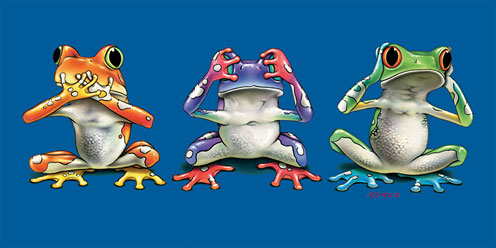Sometimes called The Three Mystic Apes, they are a Japanese pictorial maxim that reference having a good mind, speech, and action. In western culture, it can mean "turning a blind eye." Outside of Japan, the monkeys are named Mizaru, Mikazaru, and Mazaru. As for the breed of monkey, they are considered to be macaques, a common species in Japan. The source that popularized this pictorial maxim is a 17th century carving over the door of the famous Toshu-gu Temple in Nikko Japan. Carved by Hidari Jingoro, it is believed that the images incorporated Confucius's Code of Conduct, using the monkey's as a way to depict man's life cycle. There are a total of eight panels and the wise monkeys come the second panel in the series. "The philosophy, however, probably came to Japan with a Tendai-Buddhist legend, from China in the 8th century. It has been suggested that the figures represent the three dogmas of the so-called middle school of the sect."
Even though the teachings have nothing to do with monkeys, the concept of the three monkeys originated from a simple play on words. "The saying in Japanese is mizaru, kikazaru, iwazaru (見ざる, 聞かざる, 言わざる) "see not, hear not, speak not", where the -zaru is a negative conjugation on the three verbs, matching zaru, the modified form of saru (猿) "monkey" used in compounds. Thus the saying (which does not include any specific reference to "evil") can also be interpreted as referring to three monkeys."
In different cultures the proverb means different things. In Buddhist tradition the tenets of the proverb are about not dwelling on evil thoughts. In Western tradition both the proverb and the picture are often used to refer to a lack of moral responsibility on the part of the people who refuse to acknowledge impropriety, looking the other way, or feigning ignorance. It can also signify a code of silence in gangs and organized crime
Sometimes there is a variation using a fourth monkey to represent "Do no evil." He may be shown folding his arms across his chest or covering his monkey private parts. Another version, has the fourth monkey holding his nose to avoid smelling the stench.
Mathatma Gandhi's one notable exception to his lifestyle of non-possession was a small statue of the three monkeys - Bapu, Ketan and Bandar. Today, a larger representation of the three monkeys is prominently displayed at the Sabarmati Ashram in Ahmedabad Jugarat where Gandhi lived from 1915 to 1930 and from where he departed on his famous salt march.
I hope this tidbit of interesting but useless information was a fun way to start off your weekend. Whatever your plans include, please stay safe and have some fun! I invite you join me back here on Monday.
Peace

 RSS Feed
RSS Feed